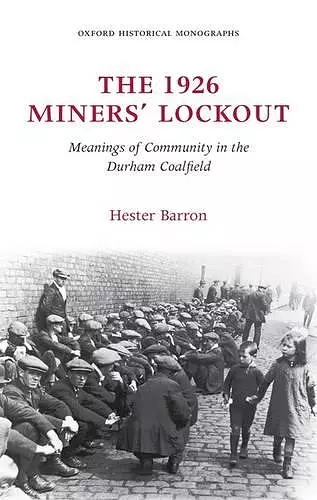The 1926 Miners' Lockout
Meanings of Community in the Durham Coalfield
Format:Hardback
Publisher:Oxford University Press
Published:10th Dec '09
Currently unavailable, and unfortunately no date known when it will be back

The miners' lockout of 1926 was a pivotal moment in British twentieth-century history. Opening with the heady days of the general strike, it continued for seven months and affected one million miners. In County Durham, where almost three in every ten adult men worked in the coal industry, its impact was profound. Hester Barron explores the way that the lockout was experienced by Durham's miners and their families. She investigates collective values and behaviour, focusing particularly on the tensions between identities based around class and occupation, and the rival identities that could cut across the creation of a cohesive community. Highlighting the continuing importance of differences due to gender, age, religion, poverty, and individual hopes and aspirations, she nevertheless finds that in 1926, despite such differences, the Durham coalfield continued to display the solidarity for which miners were famed. In response, Barron argues that the very concept of the 'mining community' needs to be reassessed. Rather than consisting of an homogeneous occupational identity, she suggests that the essence of community lay in its ability to subsume and integrate other categories of identity. A collective consciousness was further grounded in a shared historical narrative that had to be continually reinforced. It was the strength of such local solidarities that enabled both an exemplary regional response to the strike, and the ability to conceptualise such action within the wider framework of the national union. The 1926 Miners' Lockout provides crucial insights into issues of collective identity and collective action, illuminating wider debates about solidarity and fragmentation within working-class communities and cultures.
The 1926 Miners' Lockout represents a significant contribution to mining and regional historiography; it also demonstrates how innovative exploration of traditional topics can revitalise and refurbish labour and working-class history. * Alan Campbell, Times Higher Education Supplement *
an excellent monograph on the coal lockout in the Durham coalfield ... a rich tapestry * Keith Laybourn, History *
This is a deeply impressive book. Thoroughly researched, clearly written, and coping well with contradiction and complexity, as an exercise in labour history is it a model for our identity-consciounes age. * Paul Ward, English Historical Review *
Hester Barron has assembled a very rich reservoir of material ... the book offers a useful addition to the field. * Don Watson, Twentieth Century British History *
ISBN: 9780199575046
Dimensions: 223mm x 145mm x 21mm
Weight: 574g
332 pages